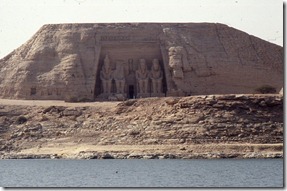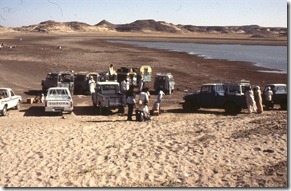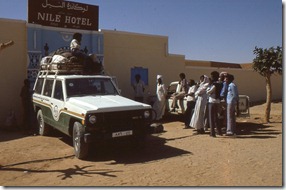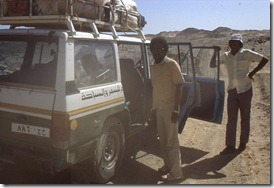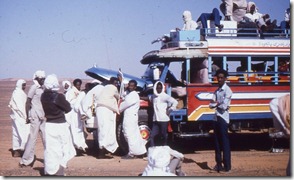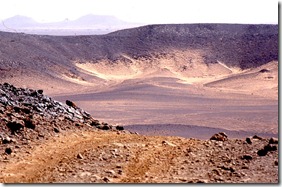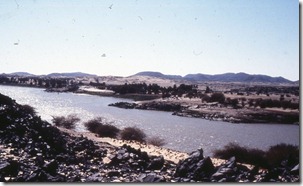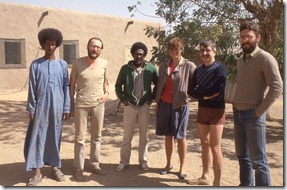In 1982 my company was hired to plan a Land Rover Safari route through the Nubian Desert, up and across the Nile Valley to Khartoum, to plan an itinerary that would take seven days, starting at Aswan in upper Egypt, across Lake Nasser and then through Sudan. The plan was produced but sadly only a few trips were made before the political situation made such journeys unsafe – a situation that has remained to the present.
Wadi Halfa is a sizeable, sprawling town on the southern fringe of Lake Nasser, at the northernmost edge of the Nubian Desert. It is also the border town between Egypt and Sudan. It is also the end of the railway line from Khartoum, the capital of Sudan. The railway had once been intended to form part of Lord Kitchener’s dream of rail communication between Khartoum and Cape Town. It had worked well during the British mandate of the Sudan but in 1982 it was not very reliable.
Above left: Abu Simbel, whose location was moved when the man-made Lake Nasser was filled. Right: arrival at Wadi Halfa.
My arrival there, with an Arabic-speaking colleague, was to meet representatives of a Khartoum-based tourism organisation anxious to set up desert safari tours through the desert and along the Nile from Wadi Halfa to Khartoum. We were to survey the area, suggest places for overnighting, sight-seeing, refreshment stops and so forth. We had arrived by a ramshackle ferry boat from Aswan in the early morning, a slow journey of one-and-a-half days across the large man-made lake. At seven in the morning we had walked off the boat with several hundred other passengers, the only Europeans, to search among the jeeps and other four-wheel-drive vehicles, plus an assorted Japanese double-cabin or two, lesser vehicles, donkeys and carts, and so forth. Quite rightly, we addressed ourselves to the most imposing looking four-wheel-drive, a Nissan Patrol, where three young Sudanese in Western dress were waiting. The leader and spokesman, who had good English, was light-brown skinned, about 5’6” and slim. He was a senior tour guide with the company in Khartoum. His assistant was slightly darker, with just a little English; and what turned out to be the driver, a tall, gangly man, was black – a Masai, who had a tremendous sense of humour and a phlegmatic approach to life.
Ahmed, the leader, said that we would spend the day in Wadi Halfa, getting supplies for the journey: food, plenty of water, gasoline and basic foodstuffs (notably bread, cheese and tomatoes). There would be no alcohol on this trip. It was essential to carry the water, too, because of the prevalence in the region of bilharzia, infected from the waters of the Nile. We were booked into a very rudimentary hotel for the night, with no catering facilities, and my colleague and I spent much of the day looking around at what shops there were, talking to local people (some of whom were very keen to acquire our Egyptian pounds), and watching the hubbub of life at the train station. We met up with our travelling companions for lunch at a local “restaurant”. This was a small, ramshackle building made of mud brick, with a half external kitchen comprising a paraffin stove, a wood-fired oven and a sink with some bottled water to “wash” the plates, all covered by a tin roof. A very dark young man in a grease-stained white gallabia, cigarette dangling from lips, was turning some meat in a pan on the stove. He opened the oven and drew out a hot, fresh loaf. We sat at a rough bare table on rough bare wooden chairs in a grimy room with dish-dash-clad Sudanese observing us from a couple of neighbouring tables. Blackened pieces of fried chicken appeared, tasting of paraffin and burnt skin. Huge, red and delicious tomatoes came on a plate along with chunks of goat cheese and a fresh loaf of bread.
Knowing of the dangers of drinking the local water we had brought with us an American-made water filter called “H2OK”, which looked somewhat like a Thermos flask. It had been developed for NASA space missions and apparently could handle anything, including one’s own urine if necessary, strained through various charcoal and other filters to produce a flow of clean and drinkable water from a little tap at the base. This aroused profound interest and amusement from the other tables, and when my colleague explained in Arabic that you could actually pee in it and drink the resultant water, they all wanted to have a go. One bold fellow stepped forward and started to lift his gallabia to the raucous encouragement of the others. We dissuaded them from such actions.
The bread looked good but was incredibly coarse, rough and gritty; but with the tomatoes and cheese it made the meal memorable. We had a similar meal that evening somewhere else before a short night on hard beds and a dawn departure into the desert on the first stage of our survey.
There was nothing of the nature of exploration about the survey. Although there are no roads across the Nubian Desert, in many areas there are well-defined tracks, because it is not always flat and there are some quite hazardous zigzag ascents and descents of rock outcrops. These are negotiated by an assortment of vehicles ranging from ancient Land Rovers to Bedford buses and very elderly trucks of the same manufacturer. Often the latter are used to transport thirty or forty or even more people, and passing one is an exuberant experience. On the open sand the tracks diverge, often confusingly. Olives, bread (when it was stale – as hard as bricks), cheese and tomatoes were the mainstay of our diet.
Ancient Bedfords cross the desert daily – and sometimes break down when everybody helps and has advice for the driver/mechanic
We spent one night by an incredible archaeological site being excavated by a team of Polish archaeologists. It was very difficult work. The desert wind blew the sand back almost as fast as it was dug out by a team of Nubian labourers. The Poles had put up what was for the area a sophisticated single-storey structure, with proper doors and windows, of mud brick and timber, which comprised a couple of dormitories, a sitting room, dining area and kitchen. There we had a European meal – the only one of our “safari” – a very presentable lamb stew, rice, salads, fruit, cheese, Polish Vodka and bottled water to accompany.
